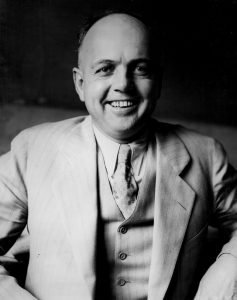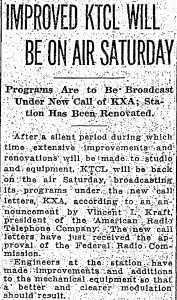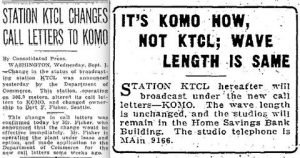
Early in 1925, the Olmsteads, in need of money to pay for Roy’s legal fees, plus maintain Elsie’s income, leased KFQX to advertising executive Birt Fisher. Birt changed the calls to KTCL in a bid to shake the station of it’s unsavoury reputation. However, he couldn’t maintain the financial end of the lease and consequently the Olmsteads sold the KFQX equipment to radio experimenter & pioneer broadcaster Vincent Kraft after Roy’s trial ended with a conviction. Vincent would use the transmitting & studio equipment to establish his own station – 570 KXA.

Seattle pioneer broadcaster Vincent Kraft purchased the assets of KFQX from the Olmsteads
Birt Fisher was in need to financing to relaunch KTCL, now authorized for 1,000 watts which required expensive tubes to provide the wattage. He approached brothers Oliver & Will Fisher (no relation) owners of Fisher Flouring Mills Inc. Oliver was quite a radio enthusiast & brother Will figured owning a radio station would be good promotion for their products. They agreed to finance a new station for Birt Fisher to operate & new equipment was ordered & an application for a new license filed. The new station was licensed to Fisher’s Blend Station Inc. & the call letters were KOMO. As we know, that station is on air operating to this very day! With Birt Fisher out of the picture, Vincent Kraft ended up acquiring the license for KFQX/KTCL from the Olmsteads & changed the calls to KXA.

Fisher’s Blend Station Inc. new station KOMO operated & managed by Birt Fisher (unrelated), born from the ashes of KTCL.
Roy Olmstead began his 4-year sentence at McNeill Island & toyed with the idea of re-entering the booze running business. He and Elsie decided that as part of this, a new radio station would be needed to provide communication to offshore boats. Their decision was to establish a new Seattle radio station, then move the facility to somewhere on or near the Wash. coast. In early 1926, Roy had a friend – a budding radio engineer & “ham” radio operator named Francis Brott apply for a license. By this time the Federal Radio Commission (FRC) was allowing applicants to choose their own call letters, and the calls chosen were KXRO with the “RO” standing for Roy’s initials. Francis had been constructing monitoring equipment for radio stations & dropped by the Fisher’s Blend offices on Harbor Island to see if they were interested in purchasing a unit. “No” was the reply, but what they really needed was an engineer to operate their new station – KOMO. Brott decide to take the job & handed over the KXRO license & facilities to Roy’s lieutenant Al Hubbard. He promptly moved the station to Aberdeen.

Listing of U.S. radio stations, 1927. Note incorrect spelling/typo naming licensee as (Francis) “Drott”. This should read BROTT.
In yet another trial associated with the Olmsteads, it was alleged that Al Hubbard used KXRO to signal waiting boats off of Grays Harbor, waiting to unload liquor. 1320 KXRO was located in a five-storey building owned by brothers “Jones & Jones” who were realtors, insurance agents & loan company operators. Federal anti-liquor agents raided the KXRO studios & shut the station down. Al Hubbard went broke & creditors the Jones Bros. ended up with possession of the station & license. One of the brothers – Lafayette Rogan Jones had been “bit by the radio bug” & was most enthused with his new station, especially when KXRO, now returned to air, began making a profit. Rogan Jones needed an experienced manager for his new station, when Harry Spence showed up in Aberdeen. Harry had previous experience working for the Olmsteads at KFQX & also at Carl Haymond’s KMO in Tacoma. Spence was put in charge of KXRO while Rogan embarked on expanding his radio empire. He next purchased KVOS radio in Seattle, moved that station to Bellingham & shortly thereafter, established & began operating KPQ in Wenatchee.

Listing of U.S. radio stations, 1928
Meanwhile, Roy Olmstead had a change of heart about re-entering the booze business while incarcerated. He made a complete turnaround becoming a Christian Science practitioner & developing skills as a carpenter. He began a prison anti-alcohol program lecturing & offering assistance to other prisoners involved with booze & racketeering. Roy was released from McNeill Island in May 1931 & returned to his Seattle home to be with his wife & daughter, & obtained employment as an insecticide salesman & fumigator. The opulent mansion in the Mt Baker neighborhood had been sold to pay off legal costs & other debts. The Olmsteads now resided in an apartment at 1220 Boren Avenue in Seattle. He began a quiet, but active community life teaching Sunday School, and making regular visits to McNeill Island & other regional prisons offering counselling to those incarcerated. The U.S. repealed Prohibition in 1933. On 25 December 1935, President Franklin D. Roosevelt granted him a full presidential pardon. Besides restoring his constitutional rights, the pardon remitted $100,000 the IRS claimed he owed in unpaid liquor taxes. Olmstead also had his unpaid $8,000 fine & court costs forgiven as part of the deal. After receiving his pardon, he next took up employment as a Credit Bureau executive.

Roy & Elsie separated in 1940, citing personal & religious differences & were granted a divorce in 1943. Roy Olmstead passed away April 30, 1966 at age 79. The mansion he & Elsie built in Seattle’s Mt Baker district remains to this day!

The Olmsteads mansion in the Mt Baker district today.




Hi Mike, I enjoyed your piece about Olmstead. Very well researched and well written. I am the author of “Seattle Prohibition: Bootleggers, Runrunners & Graft in the Queen City,” and have just finished writing a biography on Al Hubbard that is due to be published later this year. Based on your background, I think you will find the Hubbard book to be particularly interesting.